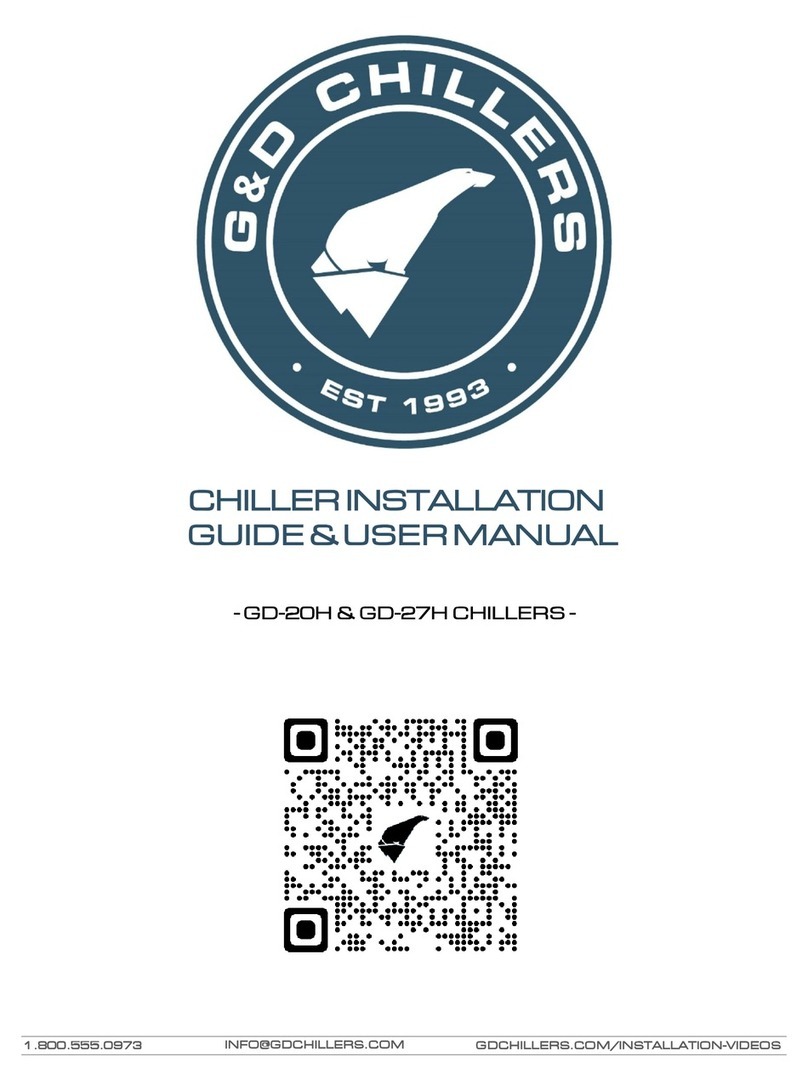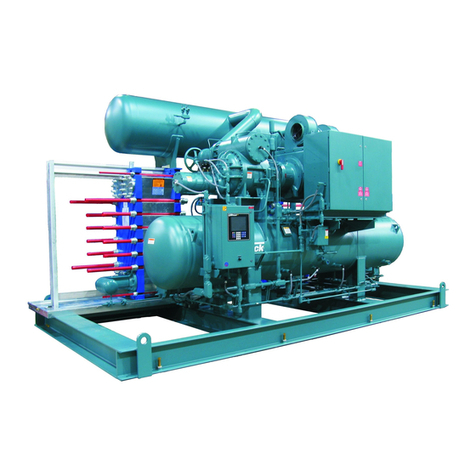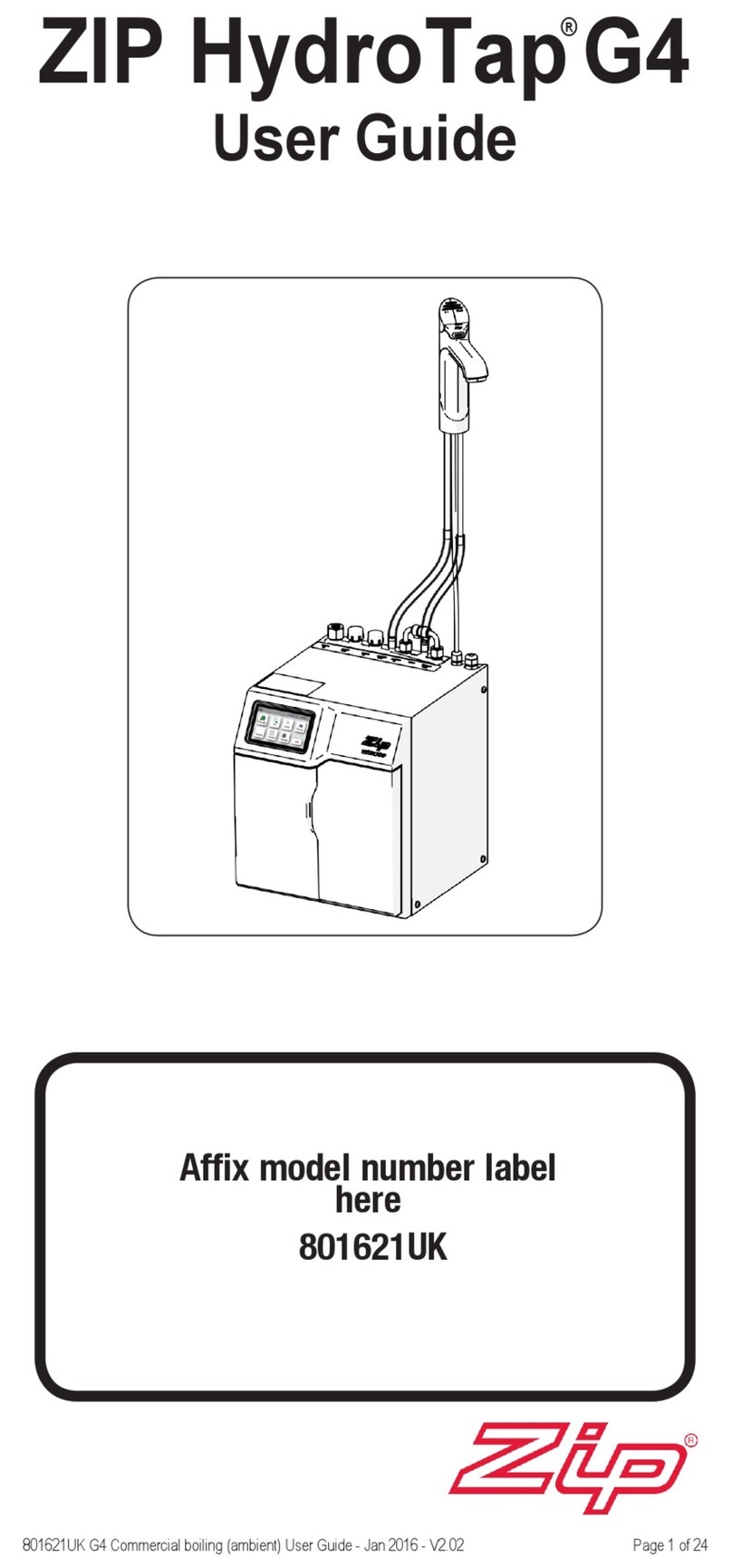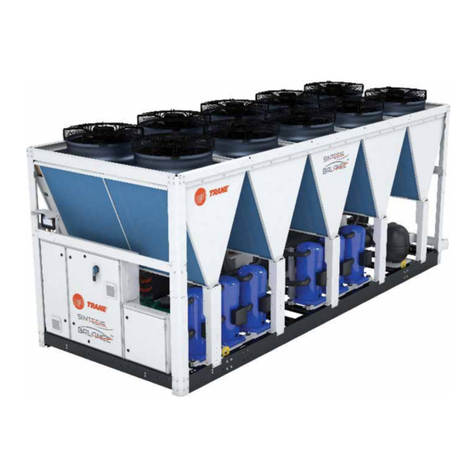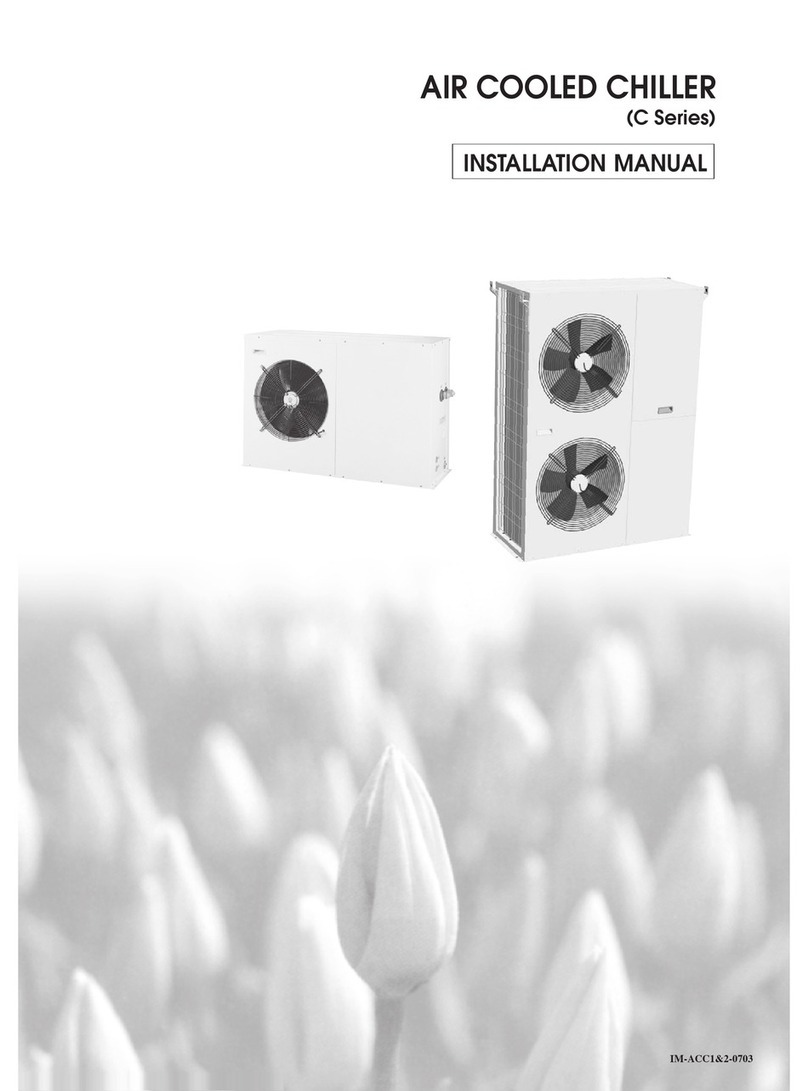G&D VERTICAL AIR Series Troubleshooting guide

1.800.555.0973 [email protected]OM GDCHILLERS.COM/INSTALLATION-VIDEOS
CHILLER INSTALLATION
GUIDE & USER MANUAL
-VERTICAL AIR SERIES -

I
2
VERTICAL AIR SERIES CHILLER MANUAL
©2022 G&D CHILLERS, INC.
ALL RIGHTS RESERVED

INSTALLATION GUIDE •USER MANUAL VERTICAL AIR SERIES
3
G&D CHILLERS, INC. • GD-VA-R2022C
CONTENTS
CONTACTINFORMATION&AFTERHOURSSUPPORT.........................................................5
INSTALLATIONVIDEOLINKS................................................................................................5
RECEIVINGYOURCHILLER...................................................................................................6
WARNINGSANDNOTICES...................................................................................................6
PACKAGECHILLERDESCRIPTION........................................................................................7
INSALLATIONOVERVIEW....................................................................................................8
INSTALLATIONREQUIREMENTSANDCONTRACTORRESPONSIBILITIES.............................9
INSTALLER‐SUPPLIEDCOMPONENTS..................................................................................9
CHILLERINSTALLATION‐MECHANICAL..............................................................................9
PIPINGRECOMMENDATIONS...........................................................................................11
ELECTRICALINSTALLATION...............................................................................................13
SEQUENCEOFOPERATION...............................................................................................13
CHILLEROPERATINGPRINCIPLES......................................................................................14
REFRIGERANTCYCLE.........................................................................................................14
CONTROLLERANDNAVIGATION.......................................................................................15
CONTROLSINTERFACE......................................................................................................18
UNITSTART‐UPPROCEDURES...........................................................................................18
PRE‐STARTCHECKOUT......................................................................................................19
FREEZEPROTECTION.........................................................................................................20

I
4
NORMALSHUTDOWN.......................................................................................................20
START‐UPINSTRUCTIONS(9EASYSTEPS).........................................................................21
WARRANTYSTART‐UPCHECKLIST....................................................................................22
TERA..................................................................................................................................23
MODELINFORMATION.....................................................................................................24
UNITNAMEPLATE.............................................................................................................24
COMPRESSORNAMEPLATE...............................................................................................25
COMPRESSORINFORMATION...........................................................................................25
COMPRESSORREPLACEMENT...........................................................................................26
POWERSUPPLYWIRING...................................................................................................28
MAINTENANCE..................................................................................................................30
MAINTENANCECHECKLIST................................................................................................33
TROUBLESHOOTING..........................................................................................................36
CARELALARMS..................................................................................................................39
PROPYLENEGLYCOLCHART..............................................................................................41
WARRANTYSTATEMENT...................................................................................................42

INSTALLATION GUIDE •USER MANUAL VERTICAL AIR SERIES
5
CONTACT INFORMATION & AFTERHOURS SUPPORT
CONTACT INFORMATION
G&D Chillers, Inc.
760 Bailey Hill Rd.
Eugene, Oregon 97402
1.800.555.0973
Office Hours: 8 AM – 5 PM PST
AFTERHOURS TECHNICAL SUPPORT
G&D Chillers offers 24/7 technical support. For emergency assistance after normal business hours, call the main office
at 1.800.555.0973. The voicemail recording will provide contact information for the emergency on-call service
technician.
INSTALLATION VIDEO LINKS
Visit the following pages for installation video walk-throughs and FAQs:
gdchillers.com/installation-videos/
gdchillers.com/installation-videos/how-to-install-a-chiller
gdchillers.com/faq
NOTICE: CHILLER WARRANTY REQUIRES ACTIVATION
To activate the chiller parts and labor limited warranty, complete the
Warranty Start-Up Checklist and return to G&D Chillers within 30 days.
G&D CHILLERS, INC. • GD-VA-R2022C

I
6
RECEIVING YOUR CHILLER
INSPECTION CHECKLIST
When the unit is delivered, verify that it is the correct unit and that it is properly equipped.
Compare the information which appears on the unit nameplate with the ordering and submittal information.
Inspect all exterior components for visible damage. Report any apparent damage or material shortage to the carrier
and make a "unit damage" notation on the carrier's delivery receipt. Specify the extent and type of damage found
and notify the G&D Sales Office at 800-555-0973.
Do not proceed with installation of a damaged unit without sales office approval.
To protect against loss due to damage incurred in transit, complete the following checklist upon receipt of the unit.
•Inspect the individual pieces of the shipment before accepting the unit. Check for obvious damage to the unit
or packing material.
•Inspect the unit for concealed damage as soon as possible after delivery and before it is stored. Concealed
damage must be reported within 5 days.
•If concealed damage is discovered, stop unpacking the shipment. Do not remove damaged material from the
receiving location. Take photos of the damage, if possible. The owner must provide reasonable evidence that
the damage did not occur after delivery.
•Notify the carrier's terminal of the damage immediately, by phone and by mail. Request an immediate, joint
inspection of the damage with the carrier and the consignee.
•Notify the G&D sales representative and arrange for repair. Do not repair the unit, however, until damage is
inspected by the carrier's representative.
WARNINGS AND NOTICES
Note that warnings and notices appear at appropriate intervals throughout this manual. Warnings are provided to
alert installing contractors to potential hazards that could result in personal injury or death. Cautions are designed
to alert personnel to hazardous situations that could result in personal injury, while notices indicate a situation that
could result in equipment or property damage only accidents.
Your personal safety and the proper operation of this machine depend upon the strict observance of these
precautions.
ATTENTION: Warnings, Cautions and Notices appear at appropriate sections throughout this
literature. Read these carefully.
WARNING: Indicates a potentially hazardous situation which, if not avoided, could result in death
or serious injury.
CAUTION: Indicates a potentially hazardous situation which, if not avoided, could result in minor
or moderate injury. It could also be used to alert against unsafe practices.
NOTICE: Indicates a situation that could result in equipment or property-damage only accidents.

I
7
PACKAGE CHILLER DESCRIPTION
CONDENSER
AIR COOLED – Standard configuration. Copper tube
aluminum fin vertical air flow condenser coil. Direct
drive propeller type fans with DDP motors and built-
in overload protection. Design test pressure 150 PSIG
low side, 300 high side.
LIQUID COOLED – Optional configuration. Brazed
plate counterflow condenser with water regulation
valve. Shell and tube condensers available for custom
units.
EVAPORATOR
Brazed plate counterflow heat exchanger fed by
electronic expansion valve (EEV).
COMPRESSOR
Hermetically-sealed Frascold compressor with oil
level sight glass, rotalock service valves, and
crankcase heater.
PUMPS
End suction centrifugal pump with impeller trimmed
for 35% propylene glycol mixture. Base mounted.
Pump fitted with union, check valve, and supply and
return shut off valves for service. Variable frequency
drives available upon request.
RESERVOIR TANK
Constructed of molded, seamless high-density cross-
linked polyethylene or stainless steel. Insulated with
½” closed cell foam. Glycol level indicator. Auxiliary
ports standard on most units.
SUPPLY & RETURN PIPING
Constructed of type M copper. Flanges provided for
field connection of supply and return piping. Liquid-
filled pressure gauge for discharge pressure.
DYNAMIC FLUID BYPASS VALVE
Allows for balancing of discharge pressure. Over
pressure design allows circuiting back to tank without
damage to system or pump. Copper and bronze
construction.
REFRIGERANT PIPING
Type L ACR copper. Liquid line-filter drier, sight
glass/moisture indicator, solenoid valve and
electronic expansion valve. Suction line fully insulated
and designed for proper oil return with minimum
friction loss. Discharge line formed of ACR tubing
reformed radius fittings. All piping leak tested and
evacuated. Ships with full operating charge of
refrigerant, refer to data plate for refrigerant type
and charge per circuit.
FRAME & HOUSING
Fully powder coated steel frame. Durable powder
coated aluminum housing rated for outdoor use.
Access panels for easy service and maintenance.
POWER & CONTROLS
A single-point electrical connection is provided for
terminating the chiller power wiring. All power
starting controls and safety/operating controls are
mounted in a weatherproof steel NEMA 3R enclosure.
Features include:
•Programmable logic controller (PLC)
•On / pump down / off door switch
•Compressor contactor and circuit breaker
•Pump contactor and circuit breaker
•Pressure-based mechanical safeties
•Flow switch interlock
•Freeze protection interlock
•High temperature alarm
•Low ambient control
•Compressor anti short cycle timer
•Variable speed drives (VFD)
•Water regulating valve (water cooled units)
FACTORY TESTING
All chillers are run tested at the factory and verified
to be in perfect working order prior to shipment.
INSTALLATION GUIDE •USER MANUAL VERTICAL AIR SERIES
G&D CHILLERS, INC. • GD-VA-R2022C

8
INSTALLATION OVERVIEW
LOCATION
Air cooled units must sit outside and be
anchored to a solid level surface. A
concrete pad is recommended. Location
should be free of grass and other debris
that could plug condenser fins.
Ensure minimum clearance* between
condenser intake side and any buildings,
walls, etc.
No walls or obstructions in front of the
unit: Louvered access side must be open
to free air. No roofs or overhangs above
chiller condenser.
Liquid cooled chillers may be installed on
a concrete pad outdoors. A properly sized
pump and liquid cooling system for the
chiller condenser must be supplied by the
end user. Contact G&D Chillers for
additional information and assistance with
sizing.
ELECTRICAL
1. Supply unit with the proper voltage and protect against power spikes.
Use only copper wire. Size wire and according to any/all applicable
local and national codes. Refer to chart to the right for proper torque
values. Refer to spec sticker on control panel for all electrical ratings.
2. Field-installed service disconnect required
3. Unit must be properly grounded at the provided grounding lug.
If multiple ground wires are used, all wires must be twisted together
prior to tightening ground lug.
4. Use only hubs or fittings that maintain the same environmental ratings
as the enclosure.
5. When turning unit off for an extended length of time, leave power
energized. (This will leave the crankcase heater on and keep the
crankcase warm for the next start up.
TORQUE CHART
Gauge
lbf-in
1000-500
550
500-4
500
350-6
375
250-6
375
4/0-6
275
2/0-14
120
#2-#3
50
#4-#6
45
#8
40
#10-#14
35
WARNING: OBEY ALL APPLICABLE LOCAL AND NATIONAL ELECTRIC CODES WHEN INSTALLING THIS EQUIPMENT
*MINIMUM CLEARANCE
REQUIREMENTS (W)
45.25" GD-30H, GD-35H,
GD-40H, GD-50H
90.5"
GD-70H, GD-100H,
GD-150H, GD-200H

INSTALLATION REQUIREMENTS AND CONTRACTOR RESPONSIBILITIES
A list of the contractor responsibilities typically associated with the unit installation process is provided.
FOUNDATION
•Meet foundation requirements
•Solid level surface
•Anchoring
RIGGING
•Safety Chains
•Clevis connectors
•Lifting beam
ELECTRICAL
•Circuit breakers (optional)
•Unit disconnect
•Electrical connections to unit mounted terminal
block
•Wiring sizes per NEC
•Ground connection(s)
•Option relays and wiring
FLUID PIPING
•Fluid strainer
•Taps for thermometers and gauges
•Thermometers
•Fluid flow pressure gauges
•Isolation and balancing valves in fluid piping
•Vents and drain
•Pressure relief valves
•Backflow prevention valves
INSULATION
•Insulation
•High humidity insulation (optional)
•Main line pipe
INSTALLER-SUPPLIED COMPONENTS
Customer wiring interface connections are shown in the electrical schematics and connection diagrams that are
shipped with the unit. The installer must provide the following components if not ordered with the unit:
•Power supply wiring (in conduit) for all field-wired connections.
•All control (interconnecting) wiring (in conduit) for field supplied devices.
•Unit disconnect (fused).
CHILLER INSTALLATION - MECHANICAL
LOCATION REQUIREMENTS SOUND CONSIDERATIONS
•Refer to G&D data sheet for sound data
•Locate the unit away from sound-sensitive areas
•Chilled fluid piping should not be supported by chiller frame
•Seal all wall penetrations
Note: Consult an acoustical engineer for critical applications.
FOUNDATION
Provide a concrete foundation of sufficient strength and mass to support the applicable operating weight (i.e.,
including completed piping, and full operating charges of refrigerant, oil and water). G&D Data sheet for unit
operating weights. Once in place, the unit must be level within 1/4" (6.4 mm) over its length and width as well as
anchored to the surface. Construct a concrete pad fully supporting the footprint of the chiller. Mount the unit directly
to the concrete pads. Level the unit using the base rail as a reference. The unit must be level within 1/4" over the
entire length. Chiller must be in contact with the concrete pad around its complete perimeter. G&D Chillers is not
responsible for equipment problems resulting from an improperly designed or constructed foundation.
9
IINSTALLATION GUIDE •USER MANUAL VERTICAL AIR SERIES
G&D CHILLERS, INC. • GD-VA-R2022C

I
10
CLEARANCES
Provide enough space around the unit to allow the installation and maintenance personnel unrestricted access to
all service points. Observe all applicable local and national codes. Refer to submittal drawings for the unit
dimensions, to provide sufficient clearance for the opening of control panel doors and unit service. All sides should
have clearance not less one full width of the condenser to any obstruction. Combined void on all four sides shall not
be less than 75%, and all obstructions should meet the minimum clearance distance listed above.
PROCESS PIPING
Cooling fluid connections are flanged.
Thoroughly flush all fluid piping to the chiller before making the final piping connections to the unit.
CAUTION: PROPER WATER TREATMENT!
The use of untreated or improperly treated water in a Chiller may result in scaling, erosion, corrosion, algae or slime.
It is recommended that the services of a qualified water treatment specialist be engaged to determine what water
treatment, if any, is required. G&D assumes no responsibility for equipment failures which result from untreated or
improperly treated water, or saline or brackish water.
VALVES AND VENTING
A vent is provided on the top of the reservoir. Be sure to provide additional vents at high points in the piping to bleed
air from the chilled fluid system. Do not pressurize reservoir. Install necessary pressure gauges to monitor the
entering and leaving chilled water pressures. Provide shutoff valves in lines to the gauges to isolate them from the
system when they are not in use. Use rubber vibration eliminators to prevent vibration transmission through the
water lines. All piping must be adequately secured and supported. If desired, install thermometers in the lines to
monitor entering and leaving fluid temperatures. Install shutoff valves on both the entering and leaving water lines
so that the chiller can be isolated for service.
CHILLER PIPING COMPONENTS
Piping components include all devices and controls used to provide proper cooling system operation and unit
operating safety.
•Air vents (to bleed air from system)
•Water pressure gauges with shutoff valves
•Vibration eliminators
•Shutoff (isolation) valves
•Thermometers (if desired)
•Fluid Strainer
The fluid strainer is field supplied, field installed and shall provide taps for the pressure gauges on the inlet and
outlet. The wye-strainer shall be installed on the return line and must be one pipe size larger than the main line
piping.
Install pressure gauges in order to measure differential pressure across the strainer. This will help to determine when
it is necessary to clean the water strainer.

11
PIPING RECOMMENDATIONS
Insulate supply and return piping
The drawing on the next page shows features that should be included in the piping system. Supplemental details
and additional recommendations are listed here:
•True union or flanged valves for serviceability
•Standard ball valve on purge line
•Additional ball valve upstream of Y-strainer for servicing
•Check valve on chiller supply line
•Two options for return line:
(1) Inverted trap with air vent valve and vacuum breaker, or
(2) Electronic actuated valve, wired to process pump starter
in chiller electrical enclosure
•Use closed-cell foam insulation
•Install protective cladding
Materials: Schedule 80 PVC or ABS typical for cold glycol/water systems
•Verify operating temperatures
•High temp systems may require copper or stainless steel piping
Install isolation ball valves externally at chiller supply and return ports
Glycol backflow prevention measures:
ADJUSTING GLYCOL SUPPLY PRESSURE
The chiller contains a dynamic fluid bypass valve on the supply line.
Refer to "CONTROLLER AND NAVIGATION" section to adjust the
pressure setting.
HANDWHEEL
PACKING NUT
FLUID BYPASS VALVE
WARNING: VERIFY TANK JACKET RATINGS BEFORE PRESSURIZING PIPING
WZ^^hZ'h'
Wye-strainer (20 mesh) on chiller return line
INSTALLATION GUIDE •USER MANUAL VERTICAL AIR SERIES
G&D CHILLERS, INC. • GD-VA-R2022C

%$,/(<+,//5'(8*(1(257(/
20 MESH WYE STRAINER
BALL VALVE
TRUE UNION BALL VALVE
TRUE UNION BALL VALVE
SUPPLY
RETURN
DETAIL F
SCALE 1 : 11
PIPE REDUCER
TRUE UNION BALL VALVE
SCH 80 PVC PIPE
ELECTRONIC ACTUATED VALVE
CHECK VALVE
SUPPLY
RETURN
AIR BLEED VALVE
VACUUM BREAKER
DETAIL B
SCALE 1 : 19
DETAIL AK
SCALE 3 : 46

INSTALLATION GUIDE •USER MANUAL VERTICAL AIR SERIES
13
ELECTRICAL INSTALLATION
GENERAL RECOMMENDATIONS
All wiring must comply with local codes and the National Electric Code. Minimum circuit ampacities and other unit
electrical data are on the unit nameplate. Specific electrical schematics and connection diagrams are shipped with
the unit.
WARNING: HAZARDOUS VOLTAGE!
Disconnect all electric power, including remote disconnects before servicing. Follow proper lock- out/tagout
procedures to ensure the power cannot be inadvertently energized. Failure to disconnect power before servicing
could result in death or serious injury.
CAUTION: USE COPPER CONDUCTORS ONLY!
Unit terminals are not designed to accept other types of conductors. Failure to use copper conductors may result in
equipment damage.
Important! Do not allow conduit to interfere with other components, structural members or equipment. Control
voltage wiring in conduit must be separate from conduit carrying low voltage (<30V) wiring. To prevent control
malfunctions, do not run low voltage wiring (<30V) in conduit with conductors carrying more than 30 volts.
SEQUENCE OF OPERATION
1. Chiller supply and return ball valves should always be open during normal operation.
2. Fluid bypass valve is factory set at 20 PSI valve design to allow minimum flow across heat exchanger when
process is not calling for cooling.
3. Pump circulates at all times when panel door switch is in the Run position.
4. Compressor control circuit is energized when pump is running.
5. If pump fails or flow fails compressor control circuit will de-energize.
6. Programmable logic controller (PLC) energizes Electronic Expansion Valve (EEV) based on leaving fluid
temperature.
7. The controller will energize the compressor starter while monitoring system pressures and flow.
8. If all parameters remain in a safe range, the compressor will continue to run until the thermostatic logic detects
that it is no longer needed. At that point, the EEV will close, the compressor will pump down and stop.
10. Door switch will pump down compressor then turn off pump if switch is shut off during compressor run cycle.
11. Line voltage power should be left on to main terminal block at all times to keep crank case heater energized
during extended off cycles.
G&D CHILLERS, INC. • GD-VA-R2022C

14
CHILLER OPERATING PRINCIPLES
This section contains an overview of the operation of air-cooled liquid chillers equipped with thermostatic control
systems.
Note: To ensure proper diagnosis and repair, contact a qualified service organization if a problem should occur.
GENERAL
The large capacity chiller unit is a reciprocating type compressor air-cooled liquid chiller. This unit is equipped with
unit-mounted starter/control panels and operates with R404A or R448A refrigerant.
BASIC COMPONENTS OF A CHILLER UNIT:
•Unit-mounted panels containing breakers, starters, and Carel controller
•Reciprocating compressors
•Brazed plate or shell-and-tube evaporators
•Air-cooled condenser
•Electronic expansion valves
•Related interconnecting pipping
REFRIGERANT CYCLE
The refrigeration cycle of the large capacity chiller is conceptually similar to other G&D air-cooled chiller products.
The chiller uses brazed plate evaporators and an air-cooled condenser. The compressors use suction gas cooled
motors and an oil management system to provide almost oil-free refrigerant to the condenser and evaporator for
maximum heat transfer while lubricating and sealing compressor bearings. The lubrication system helps to assure
long compressor life and contributes to quiet operation.
Refrigerant condenses in the air-cooled condenser.
Liquid refrigerant is metered into the brazed plate evaporators using a thermal expansion valve to maximize chiller
efficiency at full and part load operation.
The chiller is equipped with a unit-mounted starter and control panel.
The PLC-based unit control module provides accurate chilled fluid control while providing monitoring, protection and
limit functions.
The adaptive nature of the controls intelligently prevents the chiller from operating outside of its limits, or
compensates for unusual operating conditions while keeping the chiller running rather than simply shutting off the
chiller.

I
CONTROLLER AND NAVIGATION
:UP
:ENTER
:DOWN
:ALARM
:PROGRAM
:ESCAPE
:SET
:INFO
:POWER
Set Screens:
1. Glycol set point: Ensure you see in the bottom right of the display screen.
a. You can change options from SET, INFO and POWER by using the UP and DOWN
buttons.
b. Press ENTER to navigate to the glycol temperature set screen.
c. Press ENTER again to navigate to the numerical readout. Use UP and DOWN buttons to
adjust to desired setpoint.
2. Pump pressure set point: Ensure you see in the bottom right of the display screen.
a. Press DOWN until you see pump pressure set point.
b. Press ENTER button to navigate to numerical readout and adjust with UP and DOWN to
set pump pressure. Please note that pressure setpoints are preset.
Info screens:
1. Ensure you see in the bottom right portion of the display screen.
2. Press ENTER to navigate to the first information screen.
3. Use DOWN to scroll through the information screens.
Alarms:
1. Press ALARM.
2. Navigate with UP and DOWN to see current alarms.
a. To clear the alarms, press UP or DOWN through alarm screen until you see a prompt
saying “press Alarm button for 3 seconds.”
b. To check alarm history, cycle through all active alarms and press “enter to data logger.”
15
INSTALLATION GUIDE •USER MANUAL VERTICAL AIR SERIES
G&D CHILLERS, INC. • GD-VA-R2022C

012342546ÿ892ÿ521ÿ
ÿÿ!ÿ"#ÿ$%&
'
(ÿ!!)
*+88,
*+2
*-443ÿ.
*/1643ÿ0ÿ348615
*/1643ÿ0ÿ64142
*22ÿ8615
*/64411324
*592693
*748615
8
9ÿ!:ÿ!ÿÿ;&
<
9ÿ!ÿ!ÿÿ:ÿ=!ÿ">ÿ:ÿ!
!>?ÿ?>ÿ:ÿ#!ÿ$%
@AB
ÿ521ÿ
*
(;ÿ:ÿ:&
*
C!>:ÿ!>&
*
(;ÿ!!)
*D2)ÿ;ÿE
*03154);;ÿ!&
*+88);;ÿÿ!F$&
*G15);;ÿÿ!:&
*H9);;ÿÿ
;&
*+2);;ÿÿ&
*I1-J)ÿK?ÿLMÿ#ÿ:&
*I+G)ÿKNOÿ#ÿ:&
*5+G)ÿKNOÿ#ÿ:&
*JP)ÿMQÿ#ÿ:&
*
(;ÿ!!&
*
R:ÿ;!)
*Lÿ!>
*C!>:ÿ!>&
*C!>:ÿ&
>ÿ?ÿ!ÿ>ÿ#ÿ;ÿ#ÿ>ÿ!ÿ
"ÿ?>ÿÿ!ÿF!ÿÿSÿ!ÿLMTÿÿ>ÿ#:%
G392ÿ521ÿ
Oÿÿ#?ÿ!?>ÿ!!
'Uÿÿÿ?ÿ&
89ÿ!ÿ!ÿÿÿ:ÿ=!
V8'ÿ+2W+88ÿ
Q>ÿÿÿFÿÿÿÿ##ÿ#ÿ>ÿ!ÿÿ"!:ÿ
>ÿ
ÿ?>ÿÿXYYY%ÿÿ>ÿ!!ÿÿFÿ!$ÿ
Q>ÿNÿ!!ÿ=!ÿ>ÿ#?:ÿ!!!)ÿ
*:ÿÿ"#ÿF%
*Z$Fÿ#ÿ>ÿNSN##ÿ
*ÿF!ÿ"#ÿF%
*[\Lÿ"#ÿF%
[#ÿ!?>:ÿ#ÿNÿÿN##TÿNLLQC9M[ÿ:!ÿ>:>ÿ
>ÿ
!$ÿ!>:ÿ?ÿ!!ÿ?>ÿ>ÿÿ!>!ÿ?ÿ
>ÿ
!!!ÿ#?:ÿ>ÿ!>?ÿÿÿ>ÿ!>
!ÿ
?ÿ!ÿÿ#!ÿÿ
V88ÿ-4ÿ
Uÿ>!ÿÿ>ÿÿ!ÿ!ÿÿ>ÿÿ"ÿ
ÿ
]^^_%ÿÿ>ÿÿÿ"ÿÿ]^^`%ÿÿ
Fÿ
!$ÿÿÿÿ
Q>ÿ!ÿÿ!ÿ>ÿ!ÿ!ÿ!ÿ#ÿ>ÿ ÿ
ÿ
ÿ;!ÿ!ÿÿ>ÿOÿÿ
U#ÿ>ÿ!a?ÿ>:F$ÿZ$Fÿ!ÿFTÿ>ÿ
ÿ
:ÿÿ"ÿÿ]^^b%ÿÿ!ÿFÿ>:
ÿÿ
>!ÿÿ
c?:ÿÿÿ>:Tÿ>ÿÿ?ÿÿ##ÿ?>ÿ>ÿÿ
ÿ
#ÿÿÿ#ÿÿ"ÿd^`e%ÿ>ÿÿFÿ!ÿ#ÿ>ÿO
ÿ
ÿÿÿ?Z:ÿÿÿ##ÿÿ
>ÿ
;ÿÿZÿ>ÿ!!ÿ!:ÿ!!ÿF
ÿ
N>?!ÿÿ?ÿ>;ÿÿ>:>ÿ>ÿÿ
fghiÿklmlnoooÿÿÿÿÿÿÿÿ<qr'asa'stu

0123ÿ56768999ÿÿÿÿÿÿÿÿÿÿ
ÿ ! #$%
&ÿ '()*+,-ÿ./0&ÿ
12
ÿ344156789:ÿ;<ÿ=>?@ABÿ=<ÿ?2ÿCD5ÿ?6=>Aÿ=>ÿ?2ÿEAÿ
F
<=G><HÿI;=?J=>ÿGÿ6G;>?KÿK=B?Lÿ=>ÿ?2ÿC73MNHÿ?2;<ÿOI;=?J=>Oÿÿ
12
ÿ?6=>AHÿE2=B2ÿ=<ÿ<2GE>ÿ=>ÿ?2ÿ@=P;ÿAIGFHÿ2A<ÿÿI;??G><ÿ
E2G
<ÿ6A>=>P<ÿAÿK<B=IKÿIGEQÿ
RSTUVW
5=<CALÿ?2ÿ=<?ÿG@ÿAB?=FÿAA6<
XA>;ALÿ<?ÿAA6<
RYVZ
[BB<<ÿ?2ÿ6A=>ÿ6>;
R\]^
_?;
>ÿ?Gÿ?2ÿCF=G;<ÿ<B>
`aÿJcdef
gAF=PA?ÿI?E>ÿ?2ÿK=<CALÿ<B><ÿGÿ
=>BA<KBA<ÿ?2ÿFA;
J\fhiV
4E=?B2ÿ@G6ÿCAA6?ÿK=<CALÿ?GÿK=?
7G>@=6ÿFA;ÿA>Kÿ?;>ÿ?Gÿ?2ÿCAA6?ÿ=<?
jÿ0*k.
-,lÿ
12
ÿ@GGE=>Pÿ<B>ÿK=<CAL<ÿA>ÿmA6CÿG@ÿ?2ÿ6A=>ÿ<B>ÿG>
A>
AB?=Fÿ;>=?Hÿ2=P2=P2?=>Pÿ?2ÿ@=K<ÿA>Kÿ=BG><ÿ;<KQÿÿ
5A?ÿA>Kÿ1=6
7;>?ÿ;>=?ÿ<?A?;<Q
4;66ÿ6GKÿnB2=o
p=>?ÿ6GKÿn2A?ÿC;6Co
5
@G<?=>Pÿ=>ÿCGP<<nAÿB=B;=?<o
5@G<?=>Pÿ=>ÿCGP<<ÿnG>LÿG>ÿB
=B;=?o
q;ÿ@ÿBGG=>Pÿ
rA?=Aÿ@ÿBGG=>P
s7G>?GÿCGI<Hÿ<?CG=>?ÿA>Kÿ@>BÿCGI
4?A?;<ÿG@ÿ?2ÿ;>=?Q
t$!0ÿuvw
tx##ÿuvÿ$y$zw
tx##ÿuvÿuzw
tx##ÿuvÿ%{0w
tx##ÿuvÿ0 w
tx##ÿuvÿ|vux$0w
tx##ÿuvÿ%{/}x~ÿw
t#%xxy !/w
t%xzÿx!w
t0#x w
t{ !/ÿ0x !
M>K=BA?<ÿABB<<ÿ?Gÿ?2ÿ;<ÿ6>;ÿ;<=>Pÿ?2ÿrHÿ53pg
A>Kÿ:g1:_ÿL<ÿ?GÿBG>@=6
ÿk'(ÿz'+ÿ
3>ÿ?2ÿ6A=>ÿ<B>Hÿ?2ÿrÿA>Kÿ53p gÿI;??G><ÿBA>ÿIÿ;<K
ÿ?Gÿ
<BGÿ?2G;P2ÿ?2ÿ@;>B?=G><ÿA>Kÿ:g1:_ÿ;<Kÿ?Gÿ<B?ÿ?26ÿg
Gÿ
CA<<EGKÿ=<ÿ>KKÿ?GÿABB<<ÿA>KÿK=?ÿ?2<ÿCAA6?<ÿÿ
>@G
3>J3@@
4?
Msÿl+.*kÿ
12ÿP>Aÿ<L>GC?=B<ÿG@ÿ?2ÿ;>=?ÿBA>ÿIÿ<2GE>ÿ@G6ÿ?2ÿ;<
ÿ
6>;ÿ12ÿC2L<=BAÿ<?A?;<ÿG@ÿ?2ÿ=>C;?<HÿKF=BÿG;?C;?<ÿA>KÿCGI
<ÿ
AÿAFA=AIÿ=>ÿAÿ6>;ÿBG>>B?Kÿ?Gÿ?2ÿ<L>GC?=B<ÿ@ÿA>ÿ=>C;?
ÿGÿ
G;?C;?ÿ=<ÿ>G?ÿ>AIKHÿ=?<ÿ<B>ÿKG<ÿ>G?ÿACCAÿ
12ÿ=>K=F=K;Aÿ<B><ÿG@ÿ?2ÿ<L>GC?=B<ÿAÿ<2GE>ÿIGEÿ
%*(*ÿkl+.*ÿ
7=B;=?ÿ;<?ÿ@Gÿ?26GP;A?=G>
4?A?;<ÿG@ÿ?2ÿ;<?ÿCGB<<K
s:>FGCÿG>Q
t&xQÿG>ÿE=?2=>ÿGCA?=>Pÿ=6=?<
tj{*0Qÿ8=P2ÿBG6C<<=G>ÿA?=G
t{*0kQÿ8=P2ÿBG>K><=>PÿC<<;
t{*%((Qÿ8=P2ÿ6G?GÿB;>?ÿ
t{*Qÿ8=P2ÿ<
;B?=G>ÿC<<;
ty,QÿGEÿBG6C<<=G>ÿA?=G
tÿy0QGEÿK=@@>?=AÿC<<;ÿ
ty0kQGEÿBG>
K><=>PÿC<<;
tyQÿGEÿ<;B?=G>ÿC<<;
%).('kk(ÿkl+.*ÿ
7;>?ÿBG6C<<Gÿ<CKÿn957ÿG>Lo
4?A?;<ÿG@ÿBG6C<<GÿQ
s4?A?;<ÿG@ÿBG6C<<GÿQ
tÿQG@@Hÿ=>K=BA?=>PHÿ=@ÿ>B<<ALHÿ?2ÿ6A=>=>Pÿ?=6ÿI@Gÿ
<?A?=>P
tÿQG>Hÿ=>K=BA?=>PHÿ=@ÿ>B<<ALHÿ?2ÿ6A=>=>Pÿ?=6ÿI@G
<E=?B2=>PÿG@@
tz,+ÿx+QG>ÿ6A>;AL
tz,+ÿxQ
G@@ÿ6A>;AL
t#(ÿxQ@GBKÿG@@ÿILÿ:5ÿK=Fÿn>G?ÿL?ÿAKLÿ@GÿBG>?Go
t0'(QG>ÿ@GÿK@G<?ÿBLB
t).0QÿC;6CJKGE>ÿ=>ÿCGP<<
t$-()QG@@ÿK;ÿ?GÿAA6
.
.
.
.
.
.
.
.
.
.
.
.
.
.
.
.
.

I
18
CONTROLS INTERFACE
MAIN SCREEN
The Main screen is the "dashboard" of the chiller. High level status information is presented so that a user can quickly
understand the operating status of the chiller. Controller use and navigation is discussed in depth in the CONTROLLER
AND NAVIGATION section.
The Main screen is the default screen.
Additional Screens are accessible through the navigation buttons below the screen.
The current fluid temperature is indicated in the middle of the main screen. Bottom left is the chiller status indicator.
SAFETIES
Safeties include: Flow Switch, Breaker, High Head Pressure, Oil Pressure, and an ECM (Electronic Control Module).
UNIT START-UPPROCEDURES
POWER UP
When power is applied to the chiller, the HMI will boot up to the main screen. The chiller will start if both the control
power switch, and the chiller start/stop switch are in the on position. This insures automatic restart in the event of a
power outage. As with the chiller, the process pump will only start if the output power switch, and the process
pump start/stop switch are both in the on position.
CAUTION: EQUIPMENT DAMAGE!
Ensure that the oil sump heaters have been operating for a minimum of 24 hours before starting. Failure to do so
may result in equipment damage. Check oil level before starting.
CAUTION: COMPRESSOR DAMAGE!
Catastrophic damage to the compressor will occur if the isolation valves are left closed on unit start-up.
START UP
Refer to the "9 Easy Steps" document for the most current chiller start-up procedures.

I
19
PRE-START CHECKOUT
Wheninstallationiscomplete,butpriortoputtingtheunitintoservice,thefollowingprestartproceduresmustbe
reviewedandverifiedcorrect:
CAUTION: COMPRESSOR DAMAGE!
Donotoperatetheunitwiththecompressor,oildischarge,liquidlineservicevalvesandthemanualshutoffonthe
refrigerantsupplytothecondenser"CLOSED".
Failureto"OPEN"allvalvespriortostartingthecompressormaycauseseriousdamage.
Checkthepowersupplyvoltagetotheunitatthemainpowerdistributionblock.Voltagemustbewithinthe
voltageutilizationrangestampedontheunitnameplate.Voltageimbalancemustnotexceed2percent.
Checktheunitpowerphasingtobesurethatithasbeeninstalledinphasewiththephasemonitor.
Fillthechillerreservoirwiththepropersolutionoffreezeinhibitor.Ventthesystemwhileitisbeingfilled.
CAUTION: PROPER WATER TREATMENT!
Theuseofuntreatedorimproperlytreatedwaterinthechillermayresultinscaling,erosion,corrosion,algaeor
slime.Itisrecommendedthattheservicesofaqualifiedwatertreatmentspecialistbeengagedtodeterminewhat
watertreatment,ifany,isrequired.G&Dassumesnoresponsibilityforequipmentfailureswhichresultfrom
untreatedorimproperlytreatedwater,orsalineorbrackishwater.
Closethefused‐disconnectswitch(es)thatsuppliespowertothemaindistributionblock.
START-UP: OPTIMIZING REFRIGERANT CONDITIONS
Pleasenote:ThischillerutilizesaPIDformulatomaintainthefluidtemperatureasclosetothesetpointaspossible.
Attimes,thecompressorsmaycontinuetorunevenifthefluidtemperatureisbelowthesetpoint.Thisisnormal.
Note:Oncethesystemhasbeenoperatingforapproximately30minutesandhasbecomestabilized,completethe
remainingstart‐upprocedures,asfollows:
Checkandrecordthecompressorrefrigerantsuctionanddischargepressures.
Checktheliquidlinesightglassesaftersufficienttimehaselapsedtostabilizethechiller.Therefrigerantflow
pastthesightglassesshouldbeclear.Bubblesintherefrigerantindicateeitherlowrefrigerantchargeor
excessivepressuredropintheliquidlineorastuckopenexpansionvalveoriceformationintheevaporator.A
restrictioninthelinecansometimesbeidentifiedbyanoticeabletemperaturedifferentialbetweenthetwo
sidesoftherestriction.Frostwilloftenformonthelineatthispoint.Properrefrigerantchargesarelistedon
theunitnameplate.
Note:Important!Aclearsightglassalonedoesnotmeanthatthesystemisproperlycharged.Alsochecksystem
subcooling,andunitoperatingpressures.
Ashortageofrefrigerantisindicatedifoperatingpressuresarelowandsubcoolingisalsolow.Iftheoperating
pressures,sightglass,superheatandsubcoolingreadingsindicatearefrigerantshortage,gas‐chargerefrigerant
intoeachcircuit,asrequired.Withtheunitrunning,addrefrigerantvaporbyconnectingthecharginglineto
thesuctionaccumulatorandserviceportuntiloperatingconditionsbecomenormal.Slowlyaddrefrigerant.
G&D CHILLERS, INC. • GD-VA-R2022C
IINSTALLATION GUIDE •USER MANUAL VERTICAL AIR SERIES

20
CAUTION: REFRIGERANT!
Ifbothsuctionanddischargepressuresarelowbutsub‐coolingisnormal,aproblemotherthanrefrigerantshortage
exists.Donotaddrefrigerant,asthismayresultinoverchargingthecircuit.
Useonlytherefrigerantspecifiedontheunitnameplate.ContactG&Dfortherecommendedoiltypeorrefertothe
dataplateonthecompressorforyourspecificchiller.Failuretodosomaycausecompressordamageandimproper
unitoperation.
WARNING: HAZARDOUS VOLTAGE!
Disconnectallelectricpower,includingremotedisconnectsbeforeservicing.Followproperlock‐ out/tagout
procedurestoensurethepowercannotbeinadvertentlyenergized.Failuretodisconnectpowerbeforeservicing
couldresultindeathorseriousinjury.
FREEZE PROTECTION
Thechillersystemmustbeprotectedfromfreezingbyuseofafreezeinhibitor.Thesolutionmustbestrongenough
toprovideprotectionagainsticeformationatthelowestanticipatedambienttemperature,andatleast20°cooler
thanthelowestsetpoint.
Aminimumof35%PropyleneGlycolisrequired.Donotexceed40%.
NOTICE: Equipment Damage!
InordertoprovidefreezeprotectionintheeventofapowerlossyouMUSTusesufficientfreeze inhibitorinthe
chiller.
NORMAL SHUTDOWN
1. Performthenormalunitstopsequenceusingthechillerpumpdown/runswitch.
2. Verifythatthechiller,andprocesspumpsarecycledoff.
3. Verifythattheoilheatersareworking.
Note:Donotopentheexternalchillerdisconnectswitch.Thismustremainclosedtoprovidecontrolpowerfromthe
controlpowertransformertotheoilheaters.
Table of contents
Other G&D Chiller manuals
Popular Chiller manuals by other brands
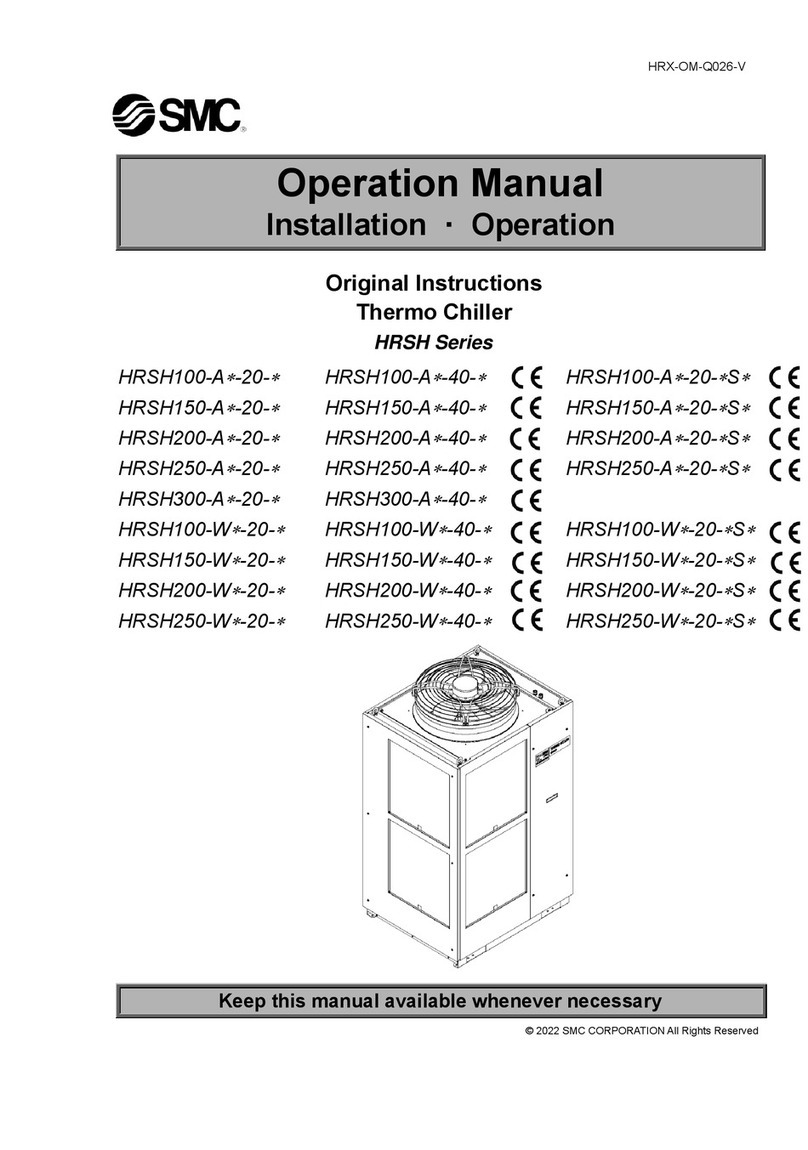
SMC Networks
SMC Networks HRSH100-A*-20 Series Operation manual

Trane
Trane CGAM Installation & operation manual

AERMEC
AERMEC NRB 0800 Installation and maintenance manual
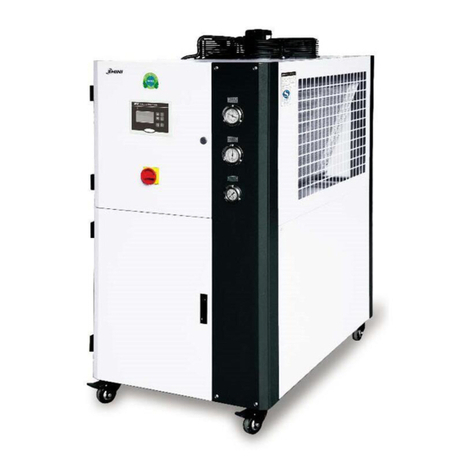
Shini
Shini SIC-A-R2 Operation manual
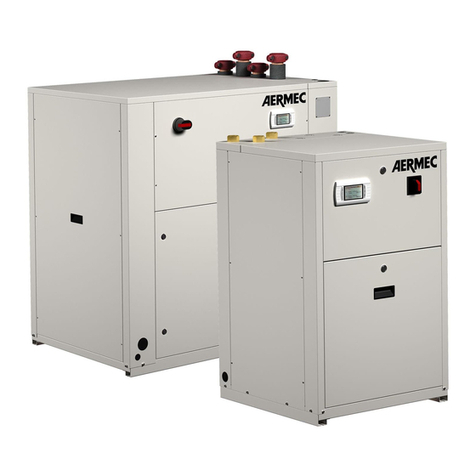
AERMEC
AERMEC WRL 200 Installation & maintenance manual
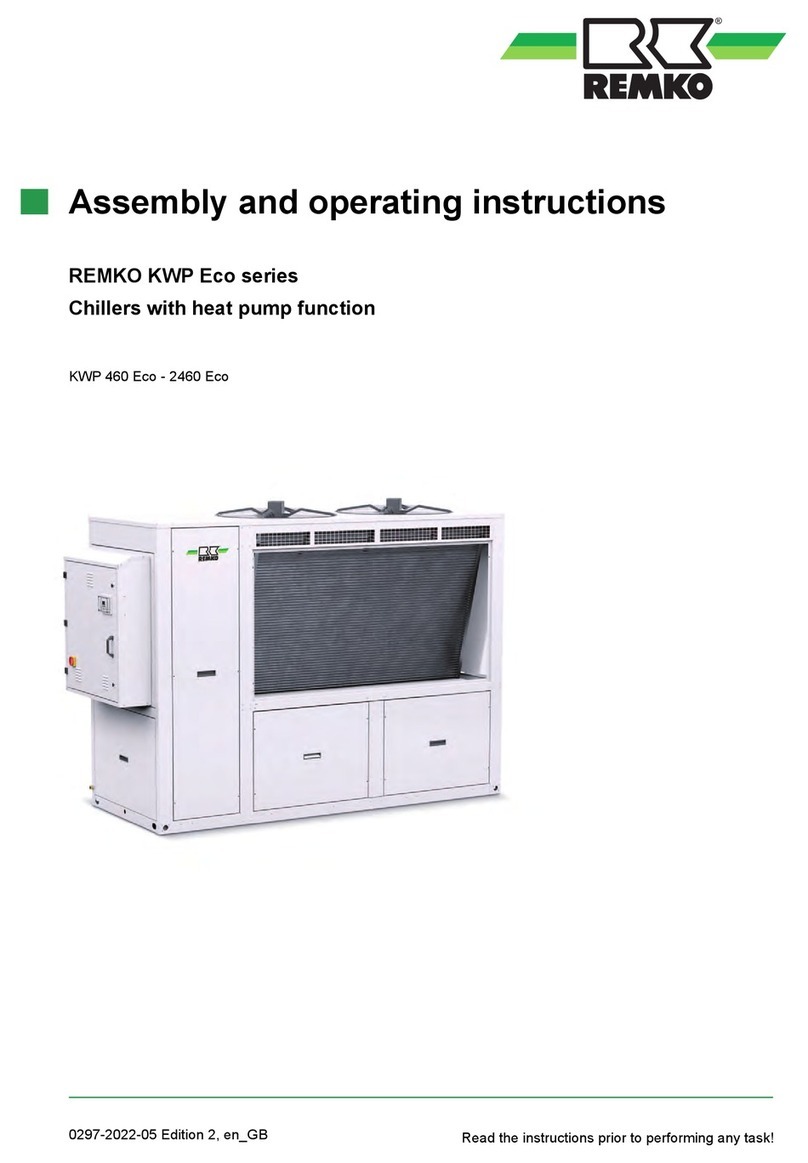
Remco
Remco KWP Eco Series Operating and installation instructions
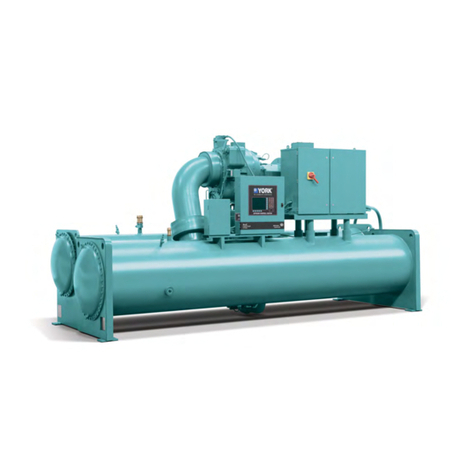
Johnson Controls
Johnson Controls York OptiView YK G Series Operation and maintenance

lancer
lancer LP2 Superchiller Installation, operation & service manual

Conair
Conair W1-1.5 user guide

Skope
Skope OD460 Service manual
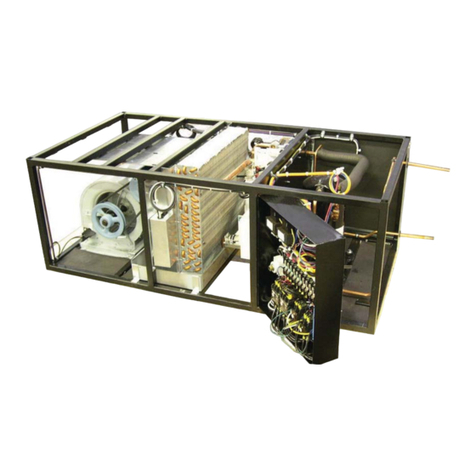
Data Aire
Data Aire MINI CEILING SERIES Installation, operation and maintenance manual

IMS
IMS MM1000 instruction manual
